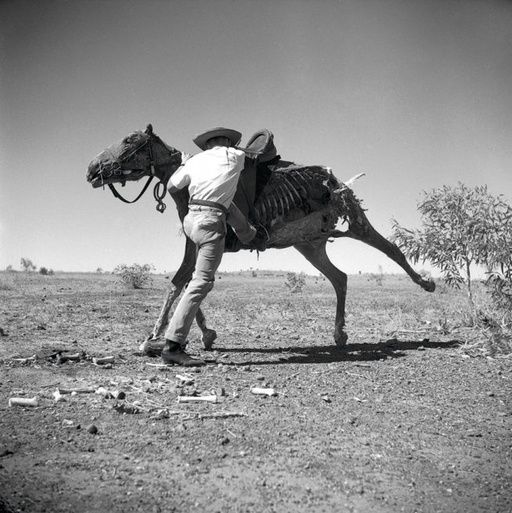

Untitled (Brian the Stockman at Wave Hill Station Mounting a Dead Horse), 1952
Sidney Nolan, Untitled (Brian the Stockman at Wave Hill Station Mounting a Dead Horse), 1952, Silver Gelatin Print
Damian Smith is a curator, arts writer and academic, the Secretary of AICA Australia (International Association of Art Critics) and the curator of the Australian contribution to the 13th Bienal de la Habana.
"In 1952 Australian artist Sidney Nolan was commissioned by the Queensland-based newspaper The Brisbane Courier-Mail to travel through rural Queensland and the Northern Territory to record a drought that was rated as the worst on record. For the farmers located there, a major challenge where cattle management was concerned was the basic lack of rail infrastructure. When the cattle were healthy teams of stockmen, known locally as ‘jackeroos’, would hear their animals along stock routes thousands of miles long. In the case of severe drought, however, the animals were effectively stranded. In that year some 250,000 perished, baked to the point of mummification in the unforgiving heat.
Studying Nolan’s artworks prior to 1952 it is hard to imagine that this lyrical Australian Modernist would produce not only paintings and drawings but also a series of near forensic photographs that recorded those desperate scenes. The harshness of the Australian ‘outback’ in its unforgiving space, heat and remoteness appear in each successive scene. Desiccated carcasses, some doubly cursed for they are stuck in trees after drowning but one season prior, leer like medieval gargoyles where others fall supine akin to the mummified animals of Pompeii. Critics at the time even drew a comparison between Nolan’s drought paintings and the death piles seen at Auschwitz, perceiving metaphors of human behaviour at its worst.
Within the sixty-one medium format photographs taken by Nolan one, in particular, stands out – ‘Brian the Stockman at Wave Hill Station Mounting a Dead Horse’. As the title suggests the solitary stockman can be seen preparing to mount a mummified horse carcass. There is no doubting that it is indeed deceased. The cadaver’s empty eye sockets are no less galvanizing than the gaping and exposed rib cage that faces the startled viewer. In contrast, the hind leg, kicked back in rigour Mortis, appears to suggest forward motion. It is a picture of the action.
Compositionally the photograph is tightly arranged; a slight vignetting of the camera lens causes the outer edges of the composition to darken, thus focusing the viewer’s attention. The rider’s leg runs at a parallel to the horse’s own front trotter. Bones are scattered on the endless plain that surrounds them, the infinite horizon creating negative shapes beneath the equine belly. Reflecting on this moment, Nolan stated, “Death takes on a curiously abstract pattern under these arid conditions. Carcasses of animals are preserved in strange shapes which have often a kind of beauty, or even grim elegance.”
But one really has to laugh! ‘Brian the Stockman at Wave Hill Station Mounting a Dead Horse’ is a visual example of Australian gallows humour – an antipodean ‘rider of the apocalypse’ off to reap its deadly bounty. Equally, however, there is a grim fascination with the conditions that caused this rotting beast to remain intact to the point where it could be saddled and potentially mounted. In conversation with an old ‘bush cocky’ as the inhabitants of remote Australia are called in a vernacular that is fast dying out, I learn that the eyes of the horse would have been pecked from its skull by crows when the animal lay dying. And extreme heat would cause sufficient contraction of the hide to keep the bodily form intact.
At the time when the photograph was taken Nolan could not have known that Wave Hill Station would later become the site of the famous Gurindji Strike of 1966 when 200 Aboriginal stockmen, led by Vincent Lingari, ‘walked off’ the station in protest of their brutal living conditions. In ‘Brian the Stockman’ we see the first representation of those challenging environs and the toughness of the Australian Aboriginal worker.
Clearly, the photograph has significance as a masterpiece of mid-20th Century photography. In the context of Australian art history, it is also the earliest example of an artwork that combines site-specific installation and performance to camera. It marks Nolan not only as a Modernist but also as a distinct precursor to the art practices one associate with post-Modernity. Of all of Nolan’s vast outpouring, this photograph remains, in my mind, a work of originality, inventiveness, forward-thinking and compositional panache. It is as artworks should be, utterly of its time and utterly timeless."